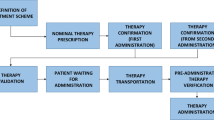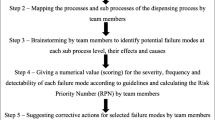Abstract
To evaluate risk and vulnerability in the chemotherapy process using a proactive risk analysis method. Healthcare failure mode and effect analysis (HFMEA) was adopted to identify potential chemotherapy process failures. A multidisciplinary team is formed to identify, evaluate, and prioritize potential failure modes based on a chemotherapy process flowchart. Subsequently, a decision tree is used to locate potential failure modes requiring urgent improvement. Finally, some recommended actions are generated and executed to eliminate possible risks. A total of 11 failure modes were identified with high hazard scores in both inpatient and outpatient processes. Computerized physician order entry was adopted to eliminate potential risks in chemotherapy processes. Chemotherapy prescription errors significantly decreased from 3.34% to 0.40%. Chemotherapy is regarded as a high-risk process. Multiple errors can occur during ordering, preparing, compounding, dispensing, and administering medications. Subsequently, these can lead to serious consequences. HFMEA is a useful tool to evaluate potential risk in healthcare processes.



Similar content being viewed by others
References
Dizon, D. S., Sabbatini, P. J., Aghajanian, C., Hensley, M. L., and Spriggs, D. R., Analysis of patients with epithelial ovarian cancer of fallopian tube carcinoma retreated with cisplatin after development of a carboplatin allergy. Gynecol. Oncol. 82:378–82, 2002.
Sheridan-Leos, N., Schulmeister, L., and Hartranft, S., Failure mode and effect analysis: a technique to prevent chemotherapy errors. Clin. J. Oncol. Nurs. 10:393–398, 2006.
Schulmeister, L., Chemotherapy medication errors: description, severity, and contributing factors. Oncol. Nurs. Forum 26:1033–1042, 1999.
Greenall, J., Failure modes and effects analysis: a tool for identifying risk in community pharmacies. Can. Pharm. J. 140:191–193, 2007.
Roland, H. E., and Moriarity, B., System safety engineering and management. Wiley, Hoboken, 1990.
Teoh, P. C., and Case, K., An evaluation of failure modes and effect analysis generating method for conceptual design. Int. J. Comput. Integr. Manuf. 18:279–293, 2005.
Joint Commission on Accreditation on Healthcare Organization, Revisions to Joint Commission standards in support of patient safety and medical/health care error reduction. Joint Commission on Accreditation on Healthcare Organization, Oakbrook Terrace, 2002.
Hambleton, M., Applying root cause analysis and failure mode and effect analysis to our compliance programs. J. Health Care Compl. 7:5–13, 2005.
Kunac, D. L., and Reith, D. M., Identification of priority for medication safety in neonatal intensive care. Drug Saf. 28:251–261, 2005.
Voeffray, M., Pannatier, A., Stupp, R., Fucina, N., Leyvraz, S., and Wasserfallen, J. B., Effect of computerisation on the quality and safety of chemotherapy prescription. Qual. Saf. Health Care 15:418–421, 2006.
Markert, A., Thierry, V., Kleber, M., et al., Chemotherapy safety and severe adverse events in cancer patients: strategies to efficiently avoid chemotherapy errors in in- and outpatient treatment. Int. J. Cancer 124:722–820, 2009.
Bonnabry, P., Cingria, L., Ackermann, M., Behrens, M., and Engelhardt, M., Use of a prospective risk analysis method to improve the safety of the cancer chemotherapy process. Int. J. Qual. Health Care 18:9–16, 2006.
American Society of Health-System Pharmacists, ASHP guidelines on preventing medication errors with antineoplastic agents. Am. J. Health Syst. Pharm. 59:1648–1668, 2002.
DeRosier, J., Stalhandske, E., Bagian, J. P., and Nudell, T., Using health care failure mode and effect analysis: the VA national center for patient safety’s prospective risk analysis system. Jt. Comm. J. Qual. Improv. 28:248–267, 2002.
Habraken, M. M., Van der Schaaf, T. W., Leistikow, I. P., et al., Prospective risk analysis of health care processes: a systematic evaluation of the use of HFMEA in Dutch health care. Ergonomics 52:809–819, 2009.
Kimehi-Woods, J., Shultz, J. P., Leistikow, I. P., and Reijnders-Thijssen, P. M., Using HFMEA to assess potential for patient harm from tubing misconnections. Jt. Comm. J. Qual. Patient Saf. 32:373–381, 2006.
van Tilburg, C. M., Leistikow, I. P., Rademaker, C. M., Bierings, M. B., and van Dijk, A. T., Health care failure mode and effect analysis: a useful proactive risk analysis in a pediatric oncology ward. Qual. Saf. Health Care 15:58–63, 2006.
Esmail, R., Cummings, C., Dersch, D., Duchscherer, G., Glowa, J., and Liggett, G., Patient safety and adverse events team. Using health care failure mode and effect analysis tool to review the process of ordering and administrating potassium chloride and potassium phosphate. Healthc. Q. 8:73–80, 2005.
Linkin, D. R., Sausman, C., Santos, L., Lyons, C., Fox, C., and Aumiller, L., Applicability of health care failure mode and effect analysis to healthcare epidemiology: evaluation of the sterilization and use of surgical instruments. Clin. Infect. Dis. 41:1014–1019, 2005.
Cohen, M. R., Anderson, R. W., Attilio, R. M., Green, L., Muller, R. J., and Pruemer, J. M., Preventing medication errors in cancer chemotherapy. Am. J. Health Syst. Pharm. 53:737–746, 1996.
Kim, G. R., Chen, A. R., Arceci, R. J., Mitchell, S. H., Kokoszka, K. M., and Daniel, D., Error reduction in pediatric chemotherapy computerized order entry and failure modes and effects analysis. Arch. Pediatr. Adolesc. Med. 160:495–498, 2006.
Author information
Authors and Affiliations
Corresponding author
Rights and permissions
About this article
Cite this article
Cheng, CH., Chou, CJ., Wang, PC. et al. Applying HFMEA to Prevent Chemotherapy Errors. J Med Syst 36, 1543–1551 (2012). https://doi.org/10.1007/s10916-010-9616-7
Received:
Accepted:
Published:
Issue Date:
DOI: https://doi.org/10.1007/s10916-010-9616-7




